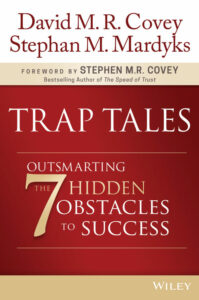7 Traps
Anyone can change the trajectory of their life, at any stage of their life.
In Trap Tales: Outsmarting the 7 Hidden Obstacles to Success, David M.R. Covey and Stephan M. Mardyks share seven traps that prevent us from achieving our potential. As the authors share each trap, they share escape routes that will help you increase your happiness and potential.
I recently spoke with David Covey about the book. David is co-CEO and cofounder of SMCOV and cofounder of ThomasLeland. (Yes, he’s also the son of one of my favorite leadership and success gurus, Stephen R. Covey, who wrote the 7 Habits of Highly Effective People.)
What is Trapology?
Trapology is the study of traps and more specifically the study of the 7 common and modern traps (contained in our book Trap Tales) that people fall into in life and work.
4 Characteristics of a Trap
How do you spot the traps before you’re ensnared? What are the characteristics of a trap?
You can’t spot traps unless you are aware of what potential traps are out there. We often describe traps as “hidden” because we can’t see them—we stumble upon one and fall in it before we realize it is a trap. So, our book, Trap Tales, is a story of Alex, who has fallen into each of the 7 traps. This provides awareness of the 7 common and modern traps our society faces today.
There are four characteristics of the trap:
- Seductive—A trap lures you in unknowingly.
- Deceptive—Short-term gratification leads to long-term pain.
- Sticky—Like quicksand, a trap is difficult to get out of once you fall into it. It requires an unconventional approach to get out and stay out.
- Limiting—A trap holds you back from progressing towards your goals.
I want to ask about just a few of the traps. The money trap. What is money myopia and why is it so dangerous?
Money myopia is society’s unhealthy emphasis and focus on making money and placing money at a higher level of importance compared to our family and relationship. We see everyone else out there with more money than us, and we attempt to copy or mimic what we see them doing. We start to believe that the whole purpose of life is primarily about money, accumulating more money and showing off all the money we have.
Money is important, but it is secondary to our family and relationships.
Understand the Power of Delayed Gratification
 The focus trap. You say the best things in life take time. How do you deal with a world getting faster and demanding immediate gratification?
The focus trap. You say the best things in life take time. How do you deal with a world getting faster and demanding immediate gratification?
This is the trap—when we believe that everything should happen on our timeframes—immediately if not sooner. The modern technology advances have improved many aspects of our life, but we should also realize that a lot of the great things in life require work and effort and time—such as building a great marriage, learning to play the piano, mastering a craft, perfecting our skills at a sport, or learning a new language or skill. We shouldn’t become discouraged when we face challenges or difficulties in doing these new things. Often, we need to say “no” to the easier course or path, as many of those things are not of equal value and importance to those things that require work and effort and time to achieve.
7 Hidden Obstacles to Success
Trap 1: The Relationship Trap-Operating as a Married Single.
Trap 2: The Money Trap-The Quicksand of Debt.
Trap 3: The Focus Trap-Being Mired in the Thick of Thin Things.
Trap 4: The Change Trap-Procrastination, the Killer of Growth and Transformation.
Trap 5: The Learning Trap-Mistakes, and Why We Got it All Wrong.
Trap 6: The Career Trap-Settling, or Losing the Passion and Inspiration in Your Professional Work.
Trap 7: The Purpose Trap-Accumulation, or the Ultimate Lie We Don’t Discover until the End.
Dimensions of a Successful Career
The career trap. The conventional approach is “do what you love and everything will work out,” but you say that a successful career has four dimensions. What are they?
- Financial—Am I compensated fairly at work?
- Ideas—Am I creatively utilized at work?
- Passion—Am I passionately engaged at work?
- Purpose—Am I making a contribution at work?
These four dimensions make a successful and happy career and give us a “whole career” rather than a “fragmented career.” Too often we see people settle for a fragmented career (where only one or two of the dimensions are engaged). We should never settle. Our career should engage all four dimensions. We should have a “whole career” for the “whole people” we are (four dimensions).
Avoid the Accumulation Mentality
My favorite is the purpose trap. Talk about the accumulation mentality and why this works against us.
The accumulation mentality suggests that the purpose of life is to acquire and accumulate stuff. And the more stuff we accumulate, the more happy and successful we are. But in reality, when you read the deathbed literature, true long-term happiness comes from providing service, making meaningful contributions, and building lasting relationships. Possessions play a supporting role; they don’t precede relationships in importance.
Your story focuses on Alex and how he has fallen into the seven traps. He has epiphanies and a major transformation. Why did you choose to teach the traps in a story?
People’s hearts better engage while reading stories. They can relate to the characters and see themselves doing the same or similar things. A story form also provides the reader with a message of hope—if Alex can undergo a major transformation in his life and make changes he’s been postponing, well, then, so can I.
The core message of Trap Tales is that anybody can change the trajectory of their life, at any stage of their life. The story format shows them an inspiring example of how one family did it!
Don’t Miss: The Book of Mistakes: 9 Secrets to Creating a Successful Future
For more information, see Trap Tales: Outsmarting the 7 Hidden Obstacles to Success.

